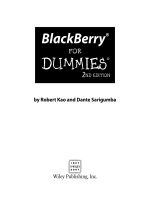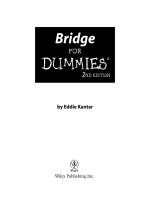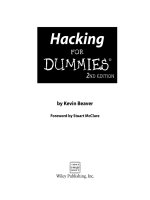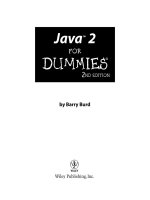Commodities for dummies, 2nd ed amine bouchentouf
Bạn đang xem bản rút gọn của tài liệu. Xem và tải ngay bản đầy đủ của tài liệu tại đây (16.07 MB, 350 trang )
Commodities For Dummies®, 2nd Edition
Visit www.dummies.com/cheatsheet/commodities to view this book's cheat
sheet.
Table of Contents
Introduction
About This Book
Conventions Used in This Book
Foolish Assumptions
How This Book Is Organized
Part I: Commodities: Just the Facts
Part II: Getting Started with Types of Investment Vehicles
Part III: The Power House: How to Make Money in Energy
Part IV: Pedal to the Metal: Investing in Metals
Part V: Going Down to the Farm: Trading Agricultural Products
Part VI: The Part of Tens
Icons Used in This Book
Where to Go from Here
Part I: Commodities: Just the Facts
Chapter 1: Investors, Start Your Engines! An Overview of Commodities
Defining Commodities and Their Investment Characteristics
Going for a Spin: Choosing the Right Investment Vehicle
The futures markets
The equity markets
Managed funds
Physical commodity purchases
Checking Out What’s on the Menu
Energy
Metals
Agricultural products
Chapter 2: Earn, Baby, Earn! Why You Should Invest in Commodities
You Can’t Argue with Success
Why the 21st Century Is the Century of Commodities
Ka-boom! Capitalizing on the global population explosion
Brick by brick: Profiting from urbanization
Full steam ahead! Benefiting from industrialization
What Makes Commodities Unique
Gaining from inelasticity
Finding a safe haven
Hedging against inflation
Taking time to bring new sources online
Sell in May and go away? Definitely nay!
Time to Get Down to Business: Commodities and the Business Cycle
Chapter 3: Investing in Commodities: Only for the Brave?
Biting Off More Than You Can Chew: The Pitfalls of Using Leverage
Watch Your Step: Understanding the Real Risks behind Commodities
Sovereign government risk
Geopolitical risk
Speculative risk
Corporate governance risk
Tracking Commodities and the 2008 Global Financial Crisis
Origins of the crisis
Overview of the crisis
Managing Risk
Due diligence: Just do it
Diversify, diversify, diversify
Chapter 4: Feel the Love: Welcoming Commodities into Your Portfolio
The Color of Money: Taking Control of Your Financial Life
Looking Ahead: Creating a Financial Road Map
Figuring out your net worth
Identifying your tax bracket
Determining your appetite for risk
Making Room in Your Portfolio for Commodities
Fully Exposed: The Top Ways to Get Exposure to Commodities
Looking toward the future with commodity futures
Funding your account with commodity funds
You’re in good company: Investing in commodity companies
Part II: Getting Started with Types of Investment Vehicles
Chapter 5: Benefiting from Exchange-Traded Funds
Getting to Know ETFs
Accessing a Variety of Commodity Markets through ETFs
Taking a Look at Leveraged ETFs
Chapter 6: Track and Trade: Investing through Commodity Indexes
Checking Out Commodity Indexes
Why indexes are useful
How to make money by using an index
From Head to Toe: Uncovering the Anatomy of a Commodity Index
Cataloguing the Five Major Indexes
The S&P Goldman Sachs Commodity Index
Reuters/Jefferies Commodity Research Bureau Index
Dow Jones–AIG Commodity Index
Rogers International Commodities Index
Deutsche Bank Liquid Commodity Index
Determining Which Index to Use
Chapter 7: Show Me the Money! Choosing the Right Manager
Mutually Beneficial: Investing in Commodity Mutual Funds
Riddle me this, riddle me that: Asking the right questions
Taking a look at what’s out there
Mastering MLPs
The ABCs of MLPs
Cash flow is king
The nuts and bolts of MLP investing
Heads up! Risk and MLPs
Relying on a Commodity Trading Advisor
Jumping into a Commodity Pool
Chapter 8: Exploring Commodity Exchanges, Brokers, and Trading Accounts
Why Do We Have Commodities Exchanges, Anyway?
Identifying the Major Commodity Exchanges
Ready, Set, Invest: Opening an Account and Placing Orders
Choosing the right account
Placing orders
Tracking your order from start to finish
Keeping up at the exchange
Owning a Piece of an Exchange
Chapter 9: Back to the Future: Getting a Grip on Futures and Options
Taking the Mystery out of Futures and Options
The Future Looks Bright: How to Trade Futures Contracts
The competition: Who trades futures?
Contract specs: Keeping track of all the moving pieces
For a Few Dollars Less: Trading Futures on Margin
Taking a Pulse: Figuring Out Where the Futures Market Is Heading
Contango: It takes two to tango
Backwardation: One step forward, two steps back
Keeping Your Options Open: Trading with Options
Following options in action
Understanding trader talk
Selecting option characteristics
Part III: The Power House: How to Make Money in Energy
Chapter 10: It’s a Crude, Crude World: Investing in Crude Oil
Seeing the Crude Realities
No need for a reservation: Examining global reserve estimates
Staying busy and productive: Looking at production figures
It’s a demanding field: Checking out demand figures
Going in and out: Eyeing imports and exports
Going Up the Crude Chain
Making Big Bucks with Big Oil
Oil companies: Lubricated and firing on all cylinders
Get your passport ready: Investing overseas
Chapter 11: Welcome to Gas Vegas, Baby! Trading Natural Gas
What’s the Use? Looking at Natural Gas Applications
Calling all captains of industry: Industrial uses of natural gas
If you can’t stand the heat, get out of the kitchen! Natural gas in your
home
Going commercial: Natural gas’s commercial uses
Truly electrifying! Generating electricity with natural gas
Getting from here to there: Natural gas and transportation
Liquefied Natural Gas: Getting Liquid Without Getting Wet
Investing in Natural Gas
Natural selection: Trading nat gas futures
Nat gas companies: The natural choice
Chapter 12: Keeping It Natural: Investing in Renewable Energy
Always Brand Spanking New: Getting to Know Renewable Energy
Sunny Delight: Investing in Solar Energy
Fast and Furious: Trading in Wind Energy
Betting on Biomass
Chapter 13: Fuel for Thought: Looking at Alternative Energy Sources
Digging Up New Energy Sources
Reexamining King Coal: Not As Scary As You Think
Coal hard facts
Paint it black
It’s a coal investment
Investing in Nuclear Power: Going Nuclear without Going Ballistic
Uranium equities
Uranium ETF
Uranium futures
You’ve Been Zapped! Trading Electricity
Brushing up on current affairs
Investing in the power industry
Chapter 14: Totally Energized: Investing in Energy Companies
Bull’s-Eye! Profiting from Oil Exploration and Production
Going offshore
Staying on dry land
Servicing the oil fields
Oh My, You’re So Refined! Investing in Refineries
Becoming an Oil Shipping Magnate
Swimming in oil: Transportation supply and demand
Crude oil ships ahoy!
Masters of the sea: Petroleum shipping companies
Swimming with sharks: Avoiding industry risk
Part IV: Pedal to the Metal: Investing in Metals
Chapter 15: All That Glitters: Investing in Gold, Silver, and Platinum
Going for the Gold
Getting to know the gold standard
Good as gold: Finding ways to invest in gold
Get the Tableware Ready: Investing in Silver
Checking out the big picture on the silver screen
Getting a sliver of silver in your portfolio
Bling Bling: Investing in Platinum
Gathering platinum facts and figures
Going platinum
Chapter 16: Metals That Prove Their Mettle: Steel, Aluminum, and Copper
Building a Portfolio That’s As Strong As Steel
Steely facts
Investing in steel companies
Aluminum: Illuminating the Details
Just the aluminum facts
Aluminum futures
Aluminum companies
Paying a Visit to Dr. Copper
Quick copper facts
Copper futures contracts
Copper companies
Chapter 17: Weighing Investments in Heavy and Not-So-Heavy Metals
Palladium: Metal for the New Millennium
Zinc and Grow Rich
You Won’t Get Nickel and Dimed by Investing in Nickel
Chapter 18: Mine Your Own Business: Unearthing the Top Mining Companies
Considering Diversified Mining Companies
BHP Billiton
Rio Tinto
Anglo-American
Checking Out Specialized Mining Companies
Newmont Mining: Gold
Silver Wheaton: Silver
Freeport McMoRan: Copper
Alcoa: Aluminum
Arcelor-Mittal: Steel
Making Money during the Mining Merger Mania
Part V: Going Down to the Farm: Trading Agricultural Products
Chapter 19: Breakfast of Champions: Profiting from Coffee, Cocoa, Sugar, and
Orange Juice
Giving Your Portfolio a Buzz by Investing in Coffee
Coffee: It’s time for your big break
The coffee futures contract: It may be your cup of tea
Ordering up investments in gourmet coffee shops
Warming Up to Cocoa
Investing in Sugar: Such a Sweet Move!
Orange Juice: Refreshingly Good for Your Bottom Line
Chapter 20: How to Gain from Grains: Trading Corn, Wheat, and Soybeans
Field of Dreams: Investing in Corn
Welcome to the Bread Basket: Investing in Wheat
It’s Not Just Peanuts: Trading Soybeans
Soybeans
Soybean oil
Soybean meal
Chapter 21: Alive and Kicking! Making Money Trading Livestock
Holy Cow! Investing in Cattle
Live cattle
Feeder cattle
Lean and Mean: Checking Out Lean Hogs
You Want Bacon with That? Trading Frozen Pork Bellies
Part VI: The Part of Tens
Chapter 22: Ten or So Investing Resources You Can’t Do Without
The Wall Street Journal
Bloomberg
Commodities-Investors.com
Nightly Business Report
Morningstar
Yahoo! Finance
Commodity Futures Trading Commission
The Energy Information Administration
Stocks and Commodities Magazine
Oil & Gas Journal
National Futures Association
Chapter 23: Top Ten Market Indicators You Should Monitor
Consumer Price Index
EIA Inventory Reports
Federal Funds Rate
Gross Domestic Product
London Gold Fix
Nonfarm Payrolls
Purchasing Managers Index
Reuters/Jefferies CRB Index
U.S. Dollar
WTI Crude Oil
Chapter 24: Top Ten Commodity ETFs
PowerShares DB Commodity Index
iPath DJ-UBS Commodity Index
United States Oil
United States Natural Gas
SPDR Gold Shares
iShares Silver Trust
iPath DJ-UBS Aluminum TR Sub-Index
PowerShares DB Agriculture Long Index
iPath DJ-UBS Coffee TR Subindex
Market Vectors Global Alternative Energy
Chapter 25: Top Ten Investment Vehicles for Commodities
Futures Commission Merchant
Commodity Trading Advisor
Commodity Pool Operator
Integrated Commodity Companies
Specialized Commodity Companies
Master Limited Partnerships
Exchange Traded Funds
Commodity Mutual Funds
Commodity Indexes
Emerging Market Funds
Glossary
Cheat Sheet
Commodities For Dummies®, 2nd Edition
by Amine Bouchentouf
Commodities For Dummies®, 2nd Edition
Published by
Wiley Publishing, Inc.
111 River St.
Hoboken, NJ 07030-5774
www.wiley.com
Copyright © 2011
Published simultaneously in Canada
No part of this publication may be reproduced, stored in a retrieval system or transmitted in any
form or by any means, electronic, mechanical, photocopying, recording, scanning or otherwise,
except as permitted under Sections 107 or 108 of the 1976 United States Copyright Act, without
either the prior written permission of the Publisher, or authorization through payment of the
appropriate per-copy fee to the Copyright Clearance Center, 222 Rosewood Drive, Danvers, MA
01923, (978) 750-8400, fax (978) 646-8600. Requests to the Publisher for permission should be
addressed to the Permissions Department, John Wiley & Sons, Inc., 111 River Street, Hoboken,
NJ 07030, (201) 748-6011, fax (201) 748-6008, or online at
/>Trademarks: Wiley, the Wiley Publishing logo, For Dummies, the Dummies Man logo, A
Reference for the Rest of Us!, The Dummies Way, Dummies Daily, The Fun and Easy Way,
Dummies.com, Making Everything Easier, and related trade dress are trademarks or registered
trademarks of John Wiley & Sons, Inc. and/or its affiliates in the United States and other countries,
and may not be used without written permission. All other trademarks are the property of their
respective owners. Wiley Publishing, Inc., is not associated with any product or vendor mentioned
in this book.
LIMIT OF LIABILITY/DISCLAIMER OF WARRANTY: THE PUBLISHER AND THE
AUTHOR MAKE NO REPRESENTATIONS OR WARRANTIES WITH RESPECT TO THE
ACCURACY OR COMPLETENESS OF THE CONTENTS OF THIS WORK AND
SPECIFICALLY DISCLAIM ALL WARRANTIES, INCLUDING WITHOUT LIMITATION
WARRANTIES OF FITNESS FOR A PARTICULAR PURPOSE. NO WARRANTY MAY BE
CREATED OR EXTENDED BY SALES OR PROMOTIONAL MATERIALS. THE ADVICE
AND STRATEGIES CONTAINED HEREIN MAY NOT BE SUITABLE FOR EVERY
SITUATION. THIS WORK IS SOLD WITH THE UNDERSTANDING THAT THE
PUBLISHER IS NOT ENGAGED IN RENDERING LEGAL, ACCOUNTING, OR OTHER
PROFESSIONAL SERVICES. IF PROFESSIONAL ASSISTANCE IS REQUIRED, THE
SERVICES OF A COMPETENT PROFESSIONAL PERSON SHOULD BE SOUGHT.
NEITHER THE PUBLISHER NOR THE AUTHOR SHALL BE LIABLE FOR DAMAGES
ARISING HEREFROM. THE FACT THAT AN ORGANIZATION OR WEBSITE IS
REFERRED TO IN THIS WORK AS A CITATION AND/OR A POTENTIAL SOURCE OF
FURTHER INFORMATION DOES NOT MEAN THAT THE AUTHOR OR THE PUBLISHER
ENDORSES THE INFORMATION THE ORGANIZATION OR WEBSITE MAY PROVIDE OR
RECOMMENDATIONS IT MAY MAKE. FURTHER, READERS SHOULD BE AWARE
THAT INTERNET WEBSITES LISTED IN THIS WORK MAY HAVE CHANGED OR
DISAPPEARED BETWEEN WHEN THIS WORK WAS WRITTEN AND WHEN IT IS READ.
For general information on our other products and services, please contact our Customer Care
Department within the U.S. at 877-762-2974, outside the U.S. at 317-572-3993, or fax 317-5724002.
For technical support, please visit www.wiley.com/techsupport.
Wiley also publishes its books in a variety of electronic formats. Some content that appears in
print may not be available in electronic books.
Library of Congress Control Number: 2011928391
ISBN: 978-1-118-01687-9
Manufactured in the United States of America
10 9 8 7 6 5 4 3 2 1
About the Author
Amine Bouchentouf is a Partner at Commodities Investors, LLC (CI), an international financial
advisory firm headquartered in New York City that provides long-term strategic advice to
individuals, institutions, and governments around the world. CI also invests directly on behalf of
clients in a wide range of industries relating to natural resources, from crude oil and gold to
natural gas and steel.
Amine is a world-renowned market commentator and has appeared in media in the United States,
Great Britain, France, the United Arab Emirates, and Brazil. He is a member of the National
Association of Securities Dealers and the Authors Guild and is also involved with the Council on
Foreign Relations. His family has been involved in the production and distribution of commodities
for more than three generations.
Amine holds a degree in economics from Middlebury College. In his spare time, he enjoys playing
golf, traveling, and socializing with friends. This is his third book. You can stay up-to-date on
Amine’s perspective on the market through the website www.commodities-investors.com.
Dedication
This book is dedicated to my most steadfast supporters — my family. You have always been there
for me when I needed you and have always supported me in every endeavor I’ve decided to
undertake. I would not have been able to accomplish half the things I’ve done without your
tremendous support, and for that I am deeply grateful.
Author’s Acknowledgments
I’d like to acknowledge the first-rate editorial team at Wiley for their input and assistance through
every stage of this process. A writer hopes for nothing more than to have a team of editors who
will support his or her general creative vision, and I was extremely fortunate to be able to follow
through on my vision for the book — from the drafting of the Table of Contents down to the
inclusion of technical charts and figures — with the guidance of a knowledgeable group of editors.
Specifically, I’d like to thank Elizabeth Rea, my project editor, for providing valuable insight
every step of the way. I’d also like to express thanks to Stacy Kennedy for helping launch the
project early on and for her continuous input throughout the writing period. I would like to show
my gratitude to the graphics department for helping me express my ideas and illustrate my points
with the help of charts, graphs, and other helpful visuals. Finally, I would like to thank McLean D.
Giles, who served as technical editor.
Since the financial markets in general, and the commodities markets in particular, are so broad and
deep, getting insight on all the different aspects of the markets is absolutely critical. I was very
fortunate that I could turn to some of the sharpest minds in finance for their insight on the markets.
I’d like to thank Dr. Scott Pardee, at Middlebury College, for providing me with cutting-edge
analysis on the cyclicality of the markets. I’d also like to acknowledge the contributions of Ray
Strong, at Goldman Sachs, regarding all aspects of the energy markets. Thanks to Karen Treanton,
at the International Energy Agency in Paris, for giving me all the vital statistical information on the
energy industry. I would like to express my appreciation to John D. Phillips and Neil McMahon, at
Alliance Bernstein, for their world-class research. Kevin Rich, at Deutsche Bank, shared with me
his knowledge of managed funds, and thanks to everyone at the NYMEX for their insights on the
futures market. Additional thanks go to Frank Ahmed, at Bear Stearns, and Richard Adler for their
general guidance. I also need to acknowledge the contributions of Elisa Castro, Heather Balke,
and, of course, my agent, Mark Sullivan.
Finally, I’d like to express my gratitude to my family, whose support was instrumental throughout
this process.
Publisher’s Acknowledgments
We’re proud of this book; please send us your comments at . For other
comments, please contact our Customer Care Department within the U.S. at 877-762-2974, outside
the U.S. at 317-572-3993, or fax 317-572-4002.
Some of the people who helped bring this book to market include the following:
Acquisitions, Editorial, and Media Development
Project Editor: Elizabeth Rea
(Previous Edition: Laura Peterson Nussbaum)
Acquisitions Editor: Stacy Kennedy
Copy Editor: Krista Hansing
Assistant Editor: David Lutton
Technical Editor: McLean D. Giles
Editorial Manager: Michelle Hacker
Editorial Assistants: Rachelle Amick, Alexa Koschier
Cover Photo: ©istockphoto.com/Justin Horrocks
Cartoons: Rich Tennant (www.the5thwave.com)
Composition Services
Project Coordinator: Nikki Gee
Layout and Graphics: Melanee Habig, Corrie Socolovitch
Proofreader: Bonnie Mikkelson
Indexer: BIM Indexing & Proofreading Services
Publishing and Editorial for Consumer Dummies
Diane Graves Steele, Vice President and Publisher, Consumer Dummies
Kristin Ferguson-Wagstaffe, Product Development Director, Consumer Dummies
Ensley Eikenburg, Associate Publisher, Travel
Kelly Regan, Editorial Director, Travel
Publishing for Technology Dummies
Andy Cummings, Vice President and Publisher, Dummies Technology/General User
Composition Services
Debbie Stailey, Director of Composition Services
Introduction
When I wrote the first edition of Commodities For Dummies, commodities were certainly not a
mainstream asset class. However, five years later, commodities have grown into their own
legitimate and respected asset class. Trade magazines and financial newsletters frequently include
feature-length articles on the topic. Financial TV stations regularly report oil, gold, and copper
prices on the crawling ticker. And no global macro money manager can claim continued success
without constantly keeping a pulse on commodities. This situation wasn’t true at the beginning of
the century, and it’s a testament to the growing importance of commodities in our globalized and
globalizing world.
Why are commodities, long regarded as an inferior asset class, quickly moving to the investing
mainstream? Good performance. Investors like to reward good performance, and commodities
have performed well in recent years. In addition, investors can more easily access these markets:
Plenty of new investment vehicles, from exchange-traded funds (ETFs) to master limited
partnerships (MLPs), have been introduced to satisfy investor demand.
As commodities have been generating more interest, there’s a large demand for a product to help
average investors get a grip on the market fundamentals. Commodities as an asset class have been
plagued by a lot of misinformation, and it’s sometimes difficult to separate fact from fiction or
outright fantasy. The aim of Commodities For Dummies is to help you figure out what
commodities are all about and, more important, develop an intelligent investment strategy to profit
in this market. Of course, as with every other asset class, commodities are subject to market
swings and disruptions, which can be a source of risk but also an opportunity. As the 2008 Global
Financial Crisis demonstrated, even the most savvy investors with the latest up-to-date market
information can struggle with unique investment events.
These disruptions are part of the market process. Investors who protect themselves through a
“margin of safety” philosophy will be able to protect their downside during periods of extreme
volatility. Using this book, you’ll better equip yourself to avoid the pitfalls inherent in any
investment activity.
About This Book
My aim in writing Commodities For Dummies, 2nd Edition, is to offer you a comprehensive guide
to the commodities markets and show you a number of investment strategies to help you profit in
this market. You don’t have to invest in just crude oil or gold futures contracts to benefit. You can
trade ETFs, invest in companies that process commodities such as uranium, buy precious metals
ownership certificates, or invest in master limited partnerships. The commodities markets are
global in nature, and so are the investment opportunities. My goal is to help you uncover these
global opportunities and offer you investment ideas and tools to unlock and unleash the power of
the commodities markets. Best of all, I do all of this in plain English!
Anyone who’s been around commodities, even for a short period of time, realizes that folks in the
business are prone to engage in linguistic acrobatics. Words like molybdenum, backwardation,
and contango are thrown around like “hello” and “thank you.” Sometimes these words seem
intimidating and confusing. Don’t be intimidated. Language is powerful, after all, and getting a grip
on the concepts behind the words is critical, especially if you want to come out ahead in the
markets. That’s why I use everyday language to explain even the most abstract and arcane
concepts.
Here are some of the trading and investing ideas you discover in the book:
Get more bang for your buck by investing through master limited partnerships,
investment vehicles used by only the most sophisticated investors. Master limited
partnerships (MLPs), which invest in energy infrastructure such as pipelines and storage
facilities, are a unique investment because they trade publicly, like a corporation, but offer
the tax benefits of a partnership. Unlike corporations, which are subject to double taxation
(on the corporate and shareholder levels), MLPs can pass their income to shareholders
tax free, so shareholders are responsible for taxes only at the individual level. Because
the primary mandate of MLPs is to distribute practically all the cash flow directly to
shareholders, you can’t afford not to invest in these hybrid vehicles. Find out how in
Chapter 6.
Capitalize on the increasing popularity of nuclear power by investing in uranium, an
investment-grade material. The use of nuclear power to generate electricity is on the
rise. As a result, the price of uranium, the primary fuel used in nuclear power plants, has
been in an extended — albeit quiet — bull market for more than a decade, quadrupling
from $10 in 1994 to $40 in 2006. Find out which companies mine this unique commodity
and how to profit from this trend in Chapter 13.
Benefit from the commodity trading craze without trading a single futures contract.
As more investors flock toward the commodities markets, the exchanges that provide
futures contracts, options, and other derivatives to commodity traders have seen their
business expand exponentially. The Chicago Mercantile Exchange (NYSE: CME), one of
the largest commodity exchanges, has seen its stock price rise from $40 since its 2003
initial public offering to more than $310 in 2011. (See Chapter 8 for more on how to
capitalize on the success of exchanges.)
Capitalize on the relationship between digital cameras and the silver markets. You
may be surprised to find that the photographic industry is a major consumer of silver,
accounting for almost 20 percent of total silver consumption. Traditional cameras use
silver halide, a silver and halogen compound, to create photographic film. However,
digital cameras, which don’t require silver halide, have decreased the demand for silver
in photography. Find out how to profit from this by betting against the price of silver,
using a trading technique known as going short, which I cover in Chapter 9. (Turn to
Chapter 15 for more on the silver markets.)
Generate a gushing stream of dividend income by investing in oil tanker stocks. One
of the best-kept secrets on Wall Street is oil tanker stocks, which provide some of the
highest dividend yields in the market. Average dividend yields for some of the industry’s
top performers are more than 12 percent, higher than even for diversified and electric
utilities (which I cover in Chapter 13).
Conventions Used in This Book
To help you make the best use of this book, I use the following conventions:
Italic is used for emphasis and to highlight new words or terms.
Boldfaced text is used to indicate key words in bulleted lists or the action parts of
numbered steps.
Monofont
is used to make Web addresses stand out for your ease.
Trading commodities requires mastering a wide variety of technical terms. The glossary tells you
what all those high-sounding financial terms actually mean so you can talk the talk, too!
Foolish Assumptions
In writing Commodities For Dummies, I made the following assumptions about you:
You have some previous investing experience but are looking to diversify your holdings.
You’re familiar with commodities trading but want to brush up on your knowledge.
Your traditional investments (stocks/bonds/mutual funds) haven’t performed according to
your expectations, and you’re looking for alternatives to maximize your returns.
You’re a new investor or someone with minimal trading experience, and you’re interested
in a broad-based investment approach that includes commodities and other assets.
You understand the attractiveness of commodities and want a comprehensive and easy-touse guide to help you get started.
You’re skeptical about the benefits of commodities but want to read about them anyway.
Please do — I’m confident that this book will change your mind!
You have little or no investment experience but are eager to find out more about investing.
This book not only explores investing in commodities, but also includes explanations of
general investing guidelines that apply to any market.
How This Book Is Organized
I’ve organized the book in a way that helps you look up essential information and analysis on the
world’s most important commodities and trading techniques. The following sections break down
each part.
Part I: Commodities: Just the Facts
The first part of Commodities For Dummies, 2nd Edition, gives you good general investing
principles. Whether you’re an experienced trader or a new investor, having a good grasp of basic
portfolio allocation methods is crucial for your success. Find out here how to create and design an
investing road map that’s specifically tailored to your financial needs and goals. You also
discover how commodities stack up against other investment vehicles, such as stocks and bonds.
In addition, I explain and dispel some of the common misconceptions regarding the commodities
markets, particularly relating to risk and volatility. I also include a whole chapter on identifying,
managing, and overcoming risk, which may be the single most important issue you face as an
investor. The fact of the matter is that any investment entails a certain degree of risk —
overcoming that risk separates successful investors from the rest. Find out how you, too, can
successfully minimize risk and maximize your returns with the help of commodities.
Part II: Getting Started with Types of Investment
Vehicles
Get the lowdown on the best investment methods you have at your disposal to invest in
commodities. I analyze the pros and cons of investing through the futures markets, the equity
markets, ETFs, and mutual funds. In addition, I examine the role of the market regulators so you
can know your rights as an investor, and I cover specific trading techniques and analyses, such as
technical and fundamental analysis. Read this part to find out how to start trading commodities.
Part III: The Power House: How to Make Money in
Energy
Energy is the largest subasset class in the commodities universe. Crude oil, for example, is the
most widely traded commodity in the world today. Natural gas, coal, and nuclear power are also
major commodities. In addition, I uncover investment opportunities in the alternative energy space
(wind and solar power) and examine the companies responsible for providing energy to the world.
Part IV: Pedal to the Metal: Investing in Metals
Metals are grouped using two criteria: whether they contain iron and, more important, whether
they resist corrosion. Metals that contain iron are called ferrous metals, and these include metals
such as zinc. Nonferrous metals, such as gold, silver, and platinum, don’t contain iron. On the
corrosion side, the metals that don’t corrode easily are usually the precious metals: gold, silver,
platinum, and palladium. Base metals, like copper, nickel, and zinc, are major industrial metals.
As you can tell, you find out everything you ever wanted to know about metals in this part.
Part V: Going Down to the Farm: Trading Agricultural
Products
Nothing is more fundamental to human life than food. In this part, find out how you can nourish and
grow your portfolio by investing in this most basic commodity. Some of the most commonly traded
agricultural products include coffee, sugar, and orange juice. I help you decipher the seasonal
nature of the business, analyze import/export activities, and consider potential obstacles so that
you can design and execute a rock-solid investment approach. Some of the commodities I discuss
in this part include orange juice, cocoa, feeder cattle, soybeans, and wheat.
Part VI: The Part of Tens
The legendary For Dummies Part of Tens chapters give you tips on how to become a better
investor and trader. Follow the ten time-tested rules that successful commodities investors have
used to make substantial profits in this area. You also get acquainted with ten of the best resources
to help you become a successful commodities investor.
This book also includes a detailed glossary that covers all the major technical terminology in these
pages. Investing in commodities can get fairly technical, so understanding the concepts behind the
words is critical for your success as an investor.
Icons Used in This Book
One of the pleasures of writing a For Dummies book is that you get to use all sorts of fun,
interactive tools to highlight or illustrate a point. Here are some icons that I use throughout the
book:
I use this icon to highlight information that you want to keep in mind or that’s referenced in
other parts of the book.
When you see this icon, make sure that you read the accompanying text carefully: It includes
information, analysis, or insight that will help you successfully implement an investment
strategy.
I explain more technical information with this icon. The commodities markets are complex,
and the vocabulary and concepts are quite tricky. You can skip these paragraphs if you just
want a quick overview of the commodities world, but be sure to read them before seriously
investing. They give you a better grasp of the concepts discussed.
Investing can be an extremely rewarding enterprise, but it can also be a hazardous endeavor
if you’re not careful. I use this icon to warn you of potential pitfalls. Stay alert for these icons
because they contain information that may help you avoid losing money.
Sometimes a potential investment requires a little extra research. When you see this icon,
get ready to analyze the investment with a fine-toothed comb. This icon lets you know that
extensive due diligence is in order.
Where to Go from Here
I’ve organized this book in a way that gives you the most accurate and relevant information related
to investing in general and commodity investing in particular. The book is modular in nature,
meaning that although it reads like a book from start to finish, you can read one chapter or even a
section at a time without needing to read the whole book to understand the topic that’s discussed.
If you’re a true beginner, however, I recommend that you read Parts I and II carefully before you
start skipping around in the chapters on particular commodities.
Part I
Commodities: Just the Facts
In this part . . .
The chapters in this part give you everything you’ve ever wanted to know about commodities. I
introduce the commodities markets and go through some of the individual commodities and how
they interact with each other. I also look at the risks of commodities investing, as well as how
commodities as an asset class compare to other assets, such as stocks and bonds.









